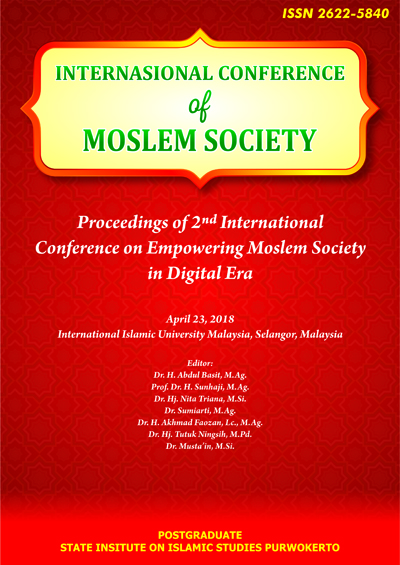The Phenomenon of Da’wa Humor Kiai Pesantren: Sociolinguistic Analysis
DOI:
https://doi.org/10.24090/icms.2018.1915Keywords:
pesantren, da'wa humor, kiai ishaq latifAbstract
This paper aims to know the model of da'wa done by kiai, and about da'wah has been discussed by (Ahmad Anas: 2006; Atmawati Dwi: 2009; and Anshori Anhar: 1984). While about humor has been discussed by (Muhammad Rohmadi: 2009; Wuri Soedjatmiko: 1991; I Dewa Putu Wijana: 2004; Danandjaja: 2001). Everything has a meaning so that humor is not a goal, but just a medium. For that purpose, the authors use a sociolinguistic perspective, as has been discussed by (Roger T. Bell: 1995; Ralp Fashold: 1990; J. A. Fishman: 1972). Therefore, what is done by Kiai Latif in his dakwah using various humorous models, such as anecdotes, comparisons, plesetan and others (Victor Raskin: 1944, James Danandjaja: 1986). Certainly, what is done by Kiai Latif in his da'wah that uses the language of dakwah humor still in the corridor of da'wah, that is as a means to invite people to not be dissolved in things that are not pleaded by Allah SWT, including inconsistent with the teachings applied by Prophet Muhammad SAW (Andy Darmawan: 2002; Clifford Geertz: 1981; Jakfar Puteh Saifullah: 2006; Aminah Mochtar: 2000).Downloads
Download data is not yet available.
Downloads
Published
2018-04-23
How to Cite
Abdullah, A. A. (2018). The Phenomenon of Da’wa Humor Kiai Pesantren: Sociolinguistic Analysis. International Conference of Moslem Society, 2. https://doi.org/10.24090/icms.2018.1915
Issue
Section
ICMS 2018
License
Authors who publish with this journal agree to the following terms:
- Authors retain copyright and grant the journal right of first publication with the work simultaneously licensed under a Creative Commons Attribution-ShareAlike 4.0 License that allows others to share the work with an acknowledgement of the work's authorship and initial publication in this journal.
- Authors are able to enter into separate, additional contractual arrangements for the non-exclusive distribution of the journal's published version of the work (e.g., post it to an institutional repository or publish it in a book), with an acknowledgement of its initial publication in this journal.
- Authors are permitted and encouraged to post their work online (e.g., in institutional repositories or on their website) prior to and during the submission process, as it can lead to productive exchanges, as well as earlier and greater citation of published work (See The Effect of Open Access).


